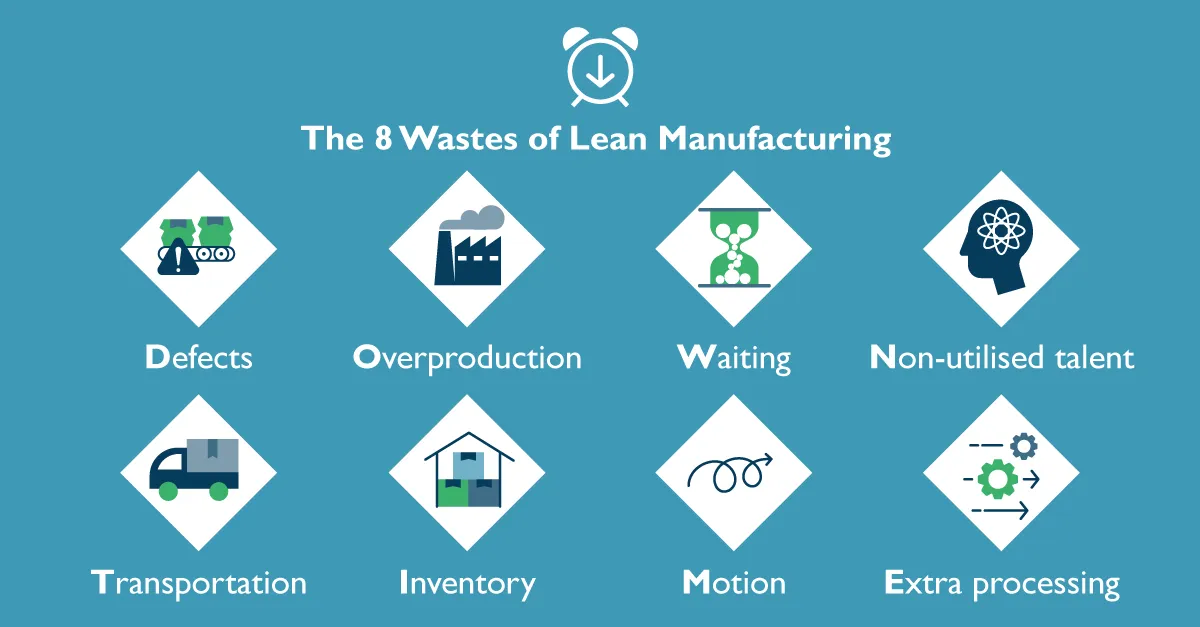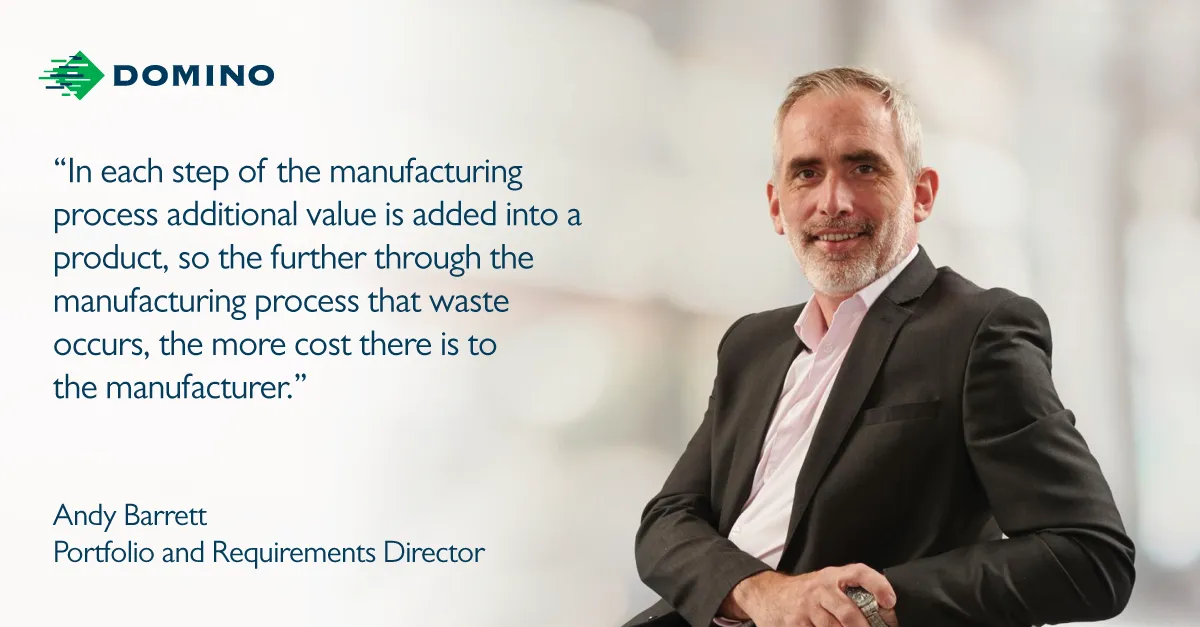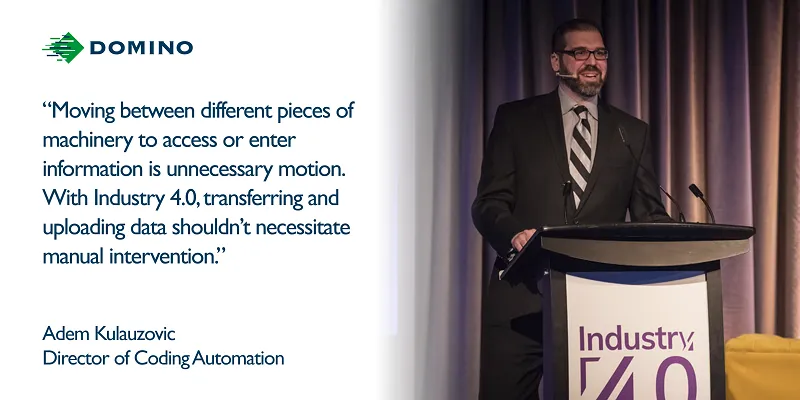Most first year Business Majors have a general awareness of Lean Manufacturing. Why? Well, its basic ideals are far from new and the concept itself is rooted from the Toyota over 70 years ago - and before that, from Ford's assembly line.
Plus, it's been hugely successful wherever it's been implemented - from other automotive manufacturers to non-hard good manufacturers.
Now, here at Domino, we rarely know about what a partner's goods are when they walk through our doorways. But if it's a company that long-standing physical production facility, we do we know there's a good chance that production process typically has a few inefficiencies - especially in the coding and marking.
How can we so bold?
While you have been optimizing and applying Lean manufacturing principles to the rest of your operation, we have been applying Lean manufacturing principles to our own operation and our own machinery and software.
Your assembly line still has to be made up of computers and components from various manufacturers.
How can you, as a decision maker, optimize your assembly line to ensure that it's up to the standards of next 20 years and not the last 70.
Manufacturers who wish to embrace Lean Manufacturing principles in the 2020s and beyond need to begin implementing nothing but components that utilize Industry 4.0 principles and automation.
In this blog post, we will highlight how manufacturers can combine Lean Manufacturing and Industry 4.0, via automation, integration, and cloud connectivity in order to reduce manufacturing waste and improve overall productivity - all while saving production cost and improving the bottom line.
These are the basic tenets that you must use to not thrive, but survive in this decade and beyond, because after the Great Pandemic Supply Chain Freeze, businesses have had no choice but to adapt.
“As a manufacturer, Domino has a real understanding of the challenge facing our customers. In our award-winning manufacturing facility in Cambridge our customers can see a factory that embraces Lean Manufacturing principles and Industry 4.0 combining the virtues of a culture of continuous improvement, with Lean design assembly process, and a connected, data-driven factory.”
Carl Haycock, UK Printer Operations Director at Domino.
The 8 Deadly Sins of Lean Manufacturing

Traditional Lean Manufacturing seeks to remove 8 specific forms of waste that occur within manufacturing operations. Since its original implementation by Toyota in the 1950s, its implementation has expanded beyond the manufacturing world into several types of businesses.
But for :
- Defects
- Overproduction
- Waiting / Time Waste
- Non-Utilized Talent
- Transportation
- Inventory
- Motion
- Extra Processing
A Lean Manufacturing Model advocates optimizing processes by eliminating the 8 wastes – allowing manufacturers to focus on value-added production processes.
In the following sections, we will highlight each of the 8 wastes of Lean in turn and speak to some of Domino’s experts in Industry 4.0 to discuss how products and solutions available from Domino can aid manufacturers on their Lean Manufacturing journey.
“At Domino, we practice what we preach, which is why our systems, together with our culture, ensure our people are highly engaged in suggesting and implementing continuous improvement ideas instead of spending time on non-value adding tasks caused by poor system design and defects. All of this puts us in the front seat when designing our solutions to help today’s manufacturers to tackle the dreaded 8 wastes of Lean.”
Carl Haycock, UK Printer Operations Director at Domino.
Defects
Whether using inkjet, TTO or laser, any type of product that has been incorrectly coded is a large cause of manufacturing waste in any operation. We've seen this within the Beverage industry, we've seen this in the food industry, we've seen this in hard goods.
Mistakes from The Great Ballooning Product Catalog
Regardless of how flawless the manufacturing process is, an incorrect tracking code can cost manufacturers significant time and money to correct. Plus, as products diversify - and market pressures have been forcing brands to make product portfolios ever-larger, with more and more variations of color, packaging, etc., built to order products and more.
Mistakes due to External Legislative Pressure
While your org has control of its own house, very few people have control of external legislation. In the United States and Canada, Eurasian tracking and coding laws often find their way here, and frankly, vice versa. The essence of what's happening is that many countries are simultaneously trying to get to the dream of one product, one code - for the lifetime of the product.
Legislation-mandated product coding requirements is a small, but hugely vital step within manufacturing operations. Even something as mundane as date coding or batch coding defects can lead to massive recalls, if not handled properly. If this coding step is missed, it can be a significant source of defects within products.
Of course, like anything else, if the issue is caught early in production, repairs can also be implemented before they become truly costly.
“The earlier you capture waste the cheaper it is to deal with,” says Andy Barrett, Portfolio and Requirements Director at Domino. “In each step of the manufacturing process additional value is added into a product, so the further through the manufacturing process that waste occurs, the more cost there is to the manufacturer – coding and marking is the final step in the process, so any waste is amplified.”
Basic Error Prevention Steps
Mistakes in product coding include incorrect information printed onto final products; issues with code quality, often caused by errors elsewhere on a production line such as speed of the line, which can lead to illegible, incomplete, missing codes; and incorrect code placement, including misaligned or misplaced codes.
Domino’s coding automation solutions were specifically developed to help production engineers eliminate or vastly reduce the risk of incorrect codes, by limiting manual data entry. By utilizing coding automation software, such as QuickDesign, manufacturers can reduce the need for manual data entry by enabling printers to automatically populate label templates based on a central database or integrate with existing an MES or ERP system to create codes based on existing production orders.
Error prevention through verification
There's an old saying that comes to mind here: Don't just trust, verify.
We're not going to sugarcoat it, but the risks of defects due to incorrect codes, poor print quality, or misplaced/misaligned codes is very real - and it can shut your lines down. But, there are tools that can help your organization reduce said risk within coding and marking. Beyond prevention, simply establishing an automatic code validation system - in place of, or beyond your hand batch validation system can vastly improve your company's ability to ensure that all information on product labels is present, correct, and readable to end users. If something like this is implemented, defects can be found earlier and waste from defects can be cut down significantly.
Integrated cameras, and vision inspection systems, such as Domino’s R-Series, can be set up to work alongside coding and marking systems to check codes and automatically remove incorrectly coded items from the line.
Systems such as this can also be set up to keep a count of all rejected codes and alert a production manager when a certain threshold has been reached. If desired, it’s also possible for systems to intervene and stop a line until an issue can be rectified.
Overproduction Prevention
Waste from overproduction can severely tax any system, if left unchecked and unbacked by data. Blindly following outdated quotas can severely test the resources of any system or organization - even a system as large, and as well-funded as an entire country.
Producing too much of a product than is needed to fulfil production quotas can be another massive cause of waste on production lines. Plus, it's not the production itself that's the end of the wasted company resource. The storage cost can also test a company's bottom line.
After all, excess product needs to be stored until it can be used, necessitating excess warehouse space, reducing the available shelf life to the end consumer, and, if/when dealing with highly-perishable items, increasing the chance of products spoiling, so it has to be scrapped.
By eliminating defects in production, manufacturers can also eliminate one of the main causes of overproduction – basic loss of faith in your company's production processes.
“If your production line has a history of high reject rates, it may make sense to overproduce to ensure that you can fulfill production quotas,” says Adem Kulauzovic, Director of Coding Automation at Domino North America. “From a coding and marking perspective, eliminating the main causes of coding errors can help reinstall trust in production systems and reduce costs due to overproducing.”
Overproduction can also occur when a manual process is required to stop a production run – we will explore more on this in the next section.

Waiting / Time Waste
Waiting for the previous step in a process to complete can be a significant cause of manufacturing waste. On busy manufacturing lines, we don't have to tell you that every single second counts – particularly in industries with slim profit margins. Manufacturers that rely on manual processes to stop production lines, and initiate product changeovers, will find themselves at risk of excess waste in the form of time waste.
QuickDesign, Domino’s coding automation software, can utilize information from production orders to work out ahead of time how much of a product is required, and set up an automatic product count, linked to an alert system, to notify a system operative to initiate a stop as soon as a required production volume is achieved.
The same system can be used to allow production staff to prepare for a product changeover ahead of time, streamlining the changeover process and reducing downtime between product runs.
“The waste of waiting can be inextricably tied to overproduction,” says Kulauzovic. “It is impossible to plan ahead to reduce the line stoppages between products if you do not know exactly when a production run needs to come to an end.”
Of course, manual operatives can be deployed to monitor printers, and initiate stops to avoid overproduction – but this would be liable to incur human error and would be a very inefficient use of people’s time.
Non-utilized talent
Automating routine tasks, is one of the surest ways to free up non-utilized talent on production lines, and ensure an engaged, optimized workforce that is better able to foster a culture of continuous improvement, in line with Lean Manufacturing principles.
“People often argue that automated systems eliminate jobs,” says Kulauzovic. “In reality, this is not the case. With Industry 4.0 you are likely to start seeing more highly-skilled job roles emerging – providing opportunities for reskilling, rather than job replacement.”
Indeed, training this new generation of manufacturing personnel is important part of the Domino service offering. A range of bespoke training courses are available alongside all of Domino’s products and solutions, to ensure that production personnel are equipped with the necessary skills and knowledge to achieve the print quality, reliability, and efficiency, that modern production lines demand.
Transportation
Excessive transport, movement, and handling of items can be a key cause of manufacturing waste – in coding and marking, unnecessary transportation of products can often be linked back to product defects.
When a defect occurs in the coding and marking of a product, the best possible outcome is reworking – by unpackaging the product and sending it back through the production line to be reprocessed and repacked – all at an additional cost to the manufacturer.
“Unfortunately, in some industries reworking defective products is not an option,” says Barrett. “In the dairy industry, for example, where there is a high risk of spoilage and contamination, whole production orders may need to be scrapped in the event of a coding error.”
Product wastage in this regard will often incur an additional cost to remove, and properly dispose of wasted products – adding additional transport waste to the mix. Fortunately, manufacturers can easily avoid this type of transportation waste, by ensuring that their coding and marking systems are optimized to avoid defects.
Inventory
Wasteful, and/or outmoded manufacturing processes inevitably lead to excess inventory in the form of product ingredients. Manufacturers who regularly overproduce will need to have excess stock in place to keep up with their overproduction.
“Holding excess stock to cater for overproduction is a vicious cycle, which is wasteful, and very inefficient in terms of cash flow,” says Barrett. “On food and beverage lines, manufacturers can also run the risk of products spoiling before they can be used.”
As we’ve seen, product defects (including defective coding) are the largest driver of overproduction within facilities. By utilizing solutions such as QuickDesign to avoid defects before they can even occur, manufacturers can avoid the need to hold onto excess ingredients. With a streamlined, automated production line, manufacturers need only to hold onto the stock that is truly needed by customers to fulfil actual production orders.
This will lower production costs, lower worker hours - and lower storage costs. We call that a win-win-win.
Motion
If transportation waste occurs in the unnecessary movement of products from one location to another, motion can be understood as the unnecessary movement of people. Industry 4.0 has opened up greater opportunities to reduce motion requirements within the production process than ever before.
“Production operatives moving between different pieces of machinery to access or enter information is unnecessary motion,” says Kulauzovic. “With Industry 4.0, transferring and uploading data shouldn’t necessitate manual intervention.”
“In the past, when setting up printers for production runs, and adding, modifying, or creating labels a person would have had to go around to every printer on a line and go through the process manually,” he continues. “With an automated coding solution from Domino, manufacturers can put all label management into a central location. A label is created or edited, from the central control point, and when it is needed it will be automatically sent to the required printer.”
Cloud communications can also be utilized to avoid unnecessary motion and provide a remote overview of how different parts of a production line are working. Manufacturers who utilize the Domino Cloud, for example, can obtain real-time information on printer performance and production metrics from anywhere in the world.

Extra processing
Coding automation, by definition, helps to remove extra processing waste – by automating manual tasks and streamlining production processes.
Traditional manufacturing methods require manual processes in place to ensure that the right data is created and printed onto the right product. When creating a batch code, for example, a production operative would need to follow a procedure to create the data, and ensure that it is correctly printed:
- Formulate the batch code using production order, date, location, etc.
- Enter the code into the printer
- Check the final product to ensure that the code printed is correct and legible
With Industry 4.0 all of these manual processes can be eliminated.
Automated coding solutions provide manufacturers with the ability to create batch, product, and date codes, and populate label templates based on existing production orders, while automatic vision systems can be used to verify product information.
In this way, the manual process of creating, entering, and checking codes can all be effectively eliminated.
Errors and inefficiencies in product coding can be a huge cause of excess manufacturing waste and an even bigger barrier to efficiency.
In industries with slim profit margins, such as food and beverage, and many fast-moving consumer goods, manufacturers need to be embrace Lean Manufacturing principles, and avoid excess waste, to remain profitable.
If you are still utilizing manual coding and marking processes within your production line – it is worth considering how the 8 wastes of Lean in coding and marking could be affecting your profits.
By partnering with a trusted coding and marking provider that has experience in system integration, coding automation, and cloud connectivity you can ensure that your coding and marking capabilities are optimized to reduce, rather than create, unnecessary manufacturing waste.
How much waste does your coding create? How much could you save by automating your processes? Contact us for more detail. Our industry experts are on hand to discuss your specific requirements and tailor a solution to suit your individual production goals.